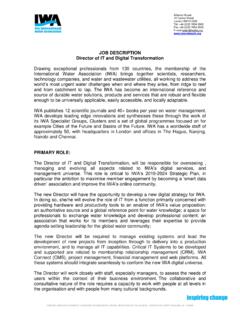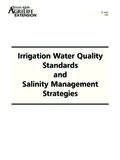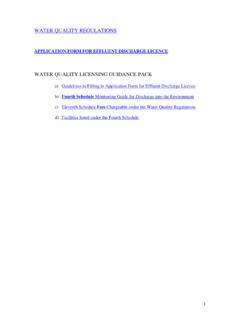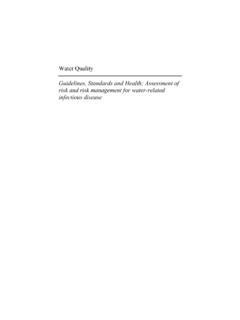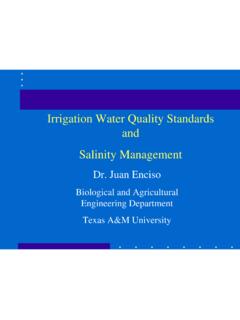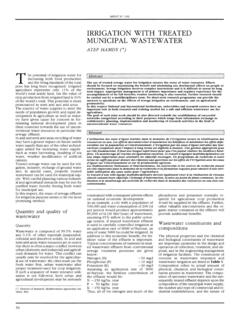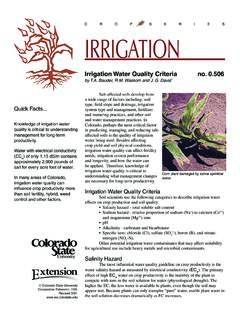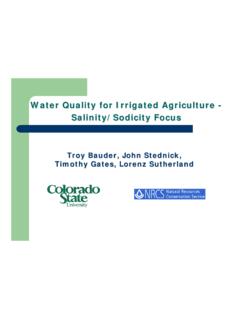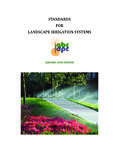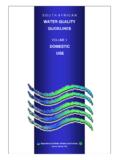Transcription of WATER QUALITY GUIDELINES - International Water Association
1 Department of WATER Affairs and ForestrySecond Edition 1996S O U T H A F R I C A NWATER QUALITYGUIDELINESVOLUME 4 AGRICULTURAL USE : IRRIGATIONSOUTH AFRICAN WATER QUALITY GUIDELINESV olume 4: Agricultural WATER Use: IrrigationSecond Edition, 1996I would like to receive future versions of this document(Please supply the information required below in block letters and mail to the given address)Name:..Organisation:..Address:.. Postal Code:..Telephone No.:..E-Mail:..Mail reply to:Director: WATER QUALITY ManagementDepartment of WATER Affairs & ForestryPrivate Bag X313 PRETORIA0001 SOUTH AFRICAS outh AfricanWater QualityGuidelinesVolume 4 Agricultural Use:IrrigationDepartment of WATER Affairs and ForestrySecond Edition1996 Published byDepartment of WATER Affairs and ForestryPrivate Bag X313 PRETORIA0001 Republic of South AfricaTel: (012) 299-9111 Printed and bound by The Government Printer, PretoriaISBN 0-7988-5338-7 (Set)ISBN 0-7988-5342-5 (Volume)Copyright reservedNo part of this publication may bereproduced in any mannerwithout full acknowledgementof the source This report should be cited as:Department of WATER Affairs and Forestry, 1996.
2 South African WATER QualityGuidelines (second edition). Volume 4: Agricultural Use: by S Holmes, CSIR Environmental ServicesProduced by:CSIR Environmental ServicesP O Box 395 PRETORIA0001 Republic of South AfricaThis volume is the fourth in a series of eight volumes comprising the South AfricanWater QUALITY GUIDELINES . Volume 1:South African WATER QUALITY GUIDELINES -Domestic WATER UseVolume 2:South African WATER QUALITY GUIDELINES -Recreational WATER UseVolume 3:South African WATER QUALITY GUIDELINES -Industrial WATER UseVolume 4:South African WATER QUALITY GUIDELINES -Agricultural WATER Use: IrrigationVolume 5:South African WATER QUALITY GUIDELINES -Agricultural WATER Use: Livestock WateringVolume 6:South African WATER QUALITY GUIDELINES -Agricultural WATER Use: AquacultureVolume 7:South African WATER QUALITY GUIDELINES -Aquatic EcosystemsVolume 8:South African WATER QUALITY GUIDELINES -Field GuideiiForewordThe Department of WATER Affairs and Forestry is the custodian of South Africa's WATER resources.
3 Partof its mission is to ensure that the QUALITY of WATER resources remains fit for recognised WATER uses andthat the viability of aquatic ecosystems are maintained and protected. These goals are achieved throughcomplex WATER QUALITY management systems which involve role players from several tiers ofgovernment, from the private sector and from civil society. A common basis from which to derive WATER QUALITY objectives is an essential requirement that enablesall role players involved in such a complex system to act in harmony in order to achieve theoverarching goal of maintaining the fitness of WATER for specific uses and to protect the health ofaquatic ecosystems. For these reasons the Department initiated the development of the South AfricanWater QUALITY GUIDELINES , of which this is the second edition. The South African WATER QualityGuidelines serve as the primary source of information for determining the WATER QUALITY requirementsof different WATER uses and for the protection and maintenance of the health of aquatic process that followed and the wide variety of organizations and individuals involved in thedevelopment of these GUIDELINES ensured the acceptance and use of these GUIDELINES by all significantrole players, as the South African WATER QUALITY GUIDELINES .
4 These GUIDELINES are technical documentsaimed at users with a basic level of expertise concerning WATER QUALITY management. However, the roleplayers involved in the different WATER use sectors are expected to use these GUIDELINES as a basis fordeveloping material to inform WATER users in specific sectors about WATER QUALITY and to empower themto effectively participate in processes aimed at determining and meeting their WATER qualityrequirements. The Department recognises that WATER QUALITY GUIDELINES are not static and will therefore update andmodify the GUIDELINES on a regular basis, as determined by ongoing research and review of local andinternational information on the effects of WATER QUALITY on WATER uses and aquatic ecosystems. Theprocess of developing WATER QUALITY GUIDELINES , and the involvement of key role players, is a continingone. The second edition is published in a loose leaf, ring binder format to facilitate the regularupdating of the GUIDELINES .
5 All those who want to comment on and make suggestions concerning theSouth African WATER QUALITY GUIDELINES are invited to do so at any time by contacting the Director: WATER QUALITY Management, Department of WATER Affairs and Forestry, Private Bag X313, I wish to express my sincere appreciation to all those who have been involved in thedevelopment of these GUIDELINES . I also look forward to their continued involvement in maintainingone of the corner-stones of the WATER QUALITY management system in South Kader Asmal MPMinister Of WATER Affairs and ForestryMay 1996 to guideline of irrigation WATER contained in the (VI).. (Faecal)..71 Copper ..77 Fluoride ..111 Nickel ..115 Nitrogen (Inorganic)..137 Sodium Adsorption Rate ..141 Sodium ..155 Suspended Solids ..161 Total Dissolved Solids ..165 Uranium ..177 Vanadium ..181 Zinc ..187 Glossary of terminology ..193 Glossary of abbreviations/acronyms.
6 197 Glossary of units of measure ..199iiiAcknowledgementsThe following individuals and organisations are thanked for their contributions to these COMMITTEEMs T Belcher, Institute for WATER QUALITY Studies, Department of WATER Affairs and ForestryDr D C Grobler, CSIR Environmental ServicesDr S Holmes, CSIR Environmental ServicesMr J L J van der Westhuizen, Department of WATER Affairs and ForestryDr H R van Vliet, Institute for WATER QUALITY Studies, Department of WATER Affairs and ForestryPROJECT TEAMMr H M du Plessis, WATER Research CommissionDr P L Kempster, Institute for WATER QUALITY Studies, Department of WATER Affairs and ForestryMr H J C Smith, Institute for Soil, Climate and WATER , Agricultural Research CouncilTECHNICAL REVIEWProf R O Barnard, Faculty of Biological and Agricultural Sciences, University of PretoriaProf J H Moolman, Department of Soil and Agricultural WATER Science, University of StellenboschSTAKEHOLDER DISTRIBUTION LISTD raft documents were distributed to the following stakeholders, and all comments received have A T P Bennie, Department of Soil Science, University of the Orange Free StateMr A F Coertze, Vegetable and Ornamental Plant Institute, Agricultural Research CouncilMr J George, South African Sugar Association Experiment StationDr M A Johnson, Department of Agronomy, University of NatalProf M C Laker, Faculty of Biological and Agricultural Sciences, University of PretoriaMr A A Louw, irrigation and Soil Conservation Research, Chief Directorate Engineering Research Ms B Njobe-Mbuli, Resource Conservation Directorate, Department of AgricultureDr J G Thompson, Consultant on WATER QUALITY and Effluent Disposal on LandDr A J van der Merwe, Institute for Soil, Climate and WATER .
7 Agricultural Research Council We also wish to thank the many people who provided administrative, secretarial and financial supportservices during the development and production of this 1 Introduction Agricultural WATER Use: irrigation 2nd Edition, 1996 (1st Issue)Introduction: Page 1 of 51 IntroductionScope and Purpose of the WATER QUALITY GUIDELINES ScopeThe South African WATER QUALITY GUIDELINES for irrigation WATER Use is essentially a userneeds specification of the QUALITY of WATER required for different irrigation uses. It isintended to provide the information to make judgements on the fitness of WATER to beused for irrigation purposes, primarily for crop production. The GUIDELINES areapplicable to any WATER that is used for irrigation purposes, irrespective of its source(municipal supply, borehole, river, etc.) or whether or not it has been South African WATER QUALITY GUIDELINES are used by the Department of WaterAffairs and Forestry as its primary source of information and decision-support to judgethe fitness for use of WATER and for other WATER QUALITY management South African WATER QUALITY GUIDELINES contain similar information to that whichis available in the International literature.
8 However, the information provided in theseguidelines is more detailed, and not only provides information on the ideal WATER qualityfor WATER uses, but in addition provides background information to help users of theguidelines make informed judgements about the fitness of WATER for use. Users of theThe South African WATER QUALITY GUIDELINES are being developed as an importantGuidelinesinformation resource, primarily for WATER QUALITY managers. Nevertheless, educators andother interested and affected members of the general public are likely to find them avaluable source of information for many aspects of WATER QUALITY and its ReviewThe South African WATER QUALITY GUIDELINES will be periodically reviewed. The purposeof the reviews is to:!Add GUIDELINES for constituents not yet included in the GUIDELINES .!Update the GUIDELINES for constituents currently included in the GUIDELINES as relevantnew information from International and local sources becomes available on the waterquality or support information for WATER QUALITY loose leaf/ring binder format of the GUIDELINES , as well as the footnotes at the bottomof each page which clearly indicate the exact version of a guideline, have been designedto facilitate regular updating of the South African WATER QUALITY GUIDELINES for irrigation WATER Use is divided into sixchapters:!
9 Chapters 1 - 4 provide an introduction to the GUIDELINES , define some important waterquality concepts, explain how irrigation WATER use was characterised for the purposeof developing these GUIDELINES , describe how the GUIDELINES were developed andprovide some guidance on how they should be used.!Chapter 5 provides the actual GUIDELINES for the different WATER QUALITY WATER Use: irrigation 2nd Edition, 1996 (1st Issue)Introduction: Page 2 of 52!Chapter 6 consists of appendices which provide additional support QualityIntroductionTo use the South African WATER QUALITY GUIDELINES correctly, it is important for users ofthe GUIDELINES to understand how WATER QUALITY and some related concepts were The term WATER QUALITY describes the physical, chemical, biological and aestheticproperties of WATER that determine its fitness for a variety of uses and for the protectionof aquatic ecosystems.
10 Many of these properties are controlled or influenced byconstituents which are either dissolved or suspended in term constituent is used generically in this edition of the South African WATER QualityGuidelines for any of the properties of WATER and/or the substances suspended ordissolved in it. In the International and local literature, several other terms are also usedto define the properties of WATER or for the substances dissolved or suspended in it, forexample WATER QUALITY variable; characteristic and determinand; of constituents which are used to describe WATER QUALITY are:!The temperature of the WATER is 20 EC.!The colour of the WATER is green.!The concentration of calcium is 60 mg/R.!Thirty percent of the surface of the WATER body is covered with WATER that none of the statements of WATER QUALITY states anything about how desirable oracceptable it is for WATER to have the properties listed.



